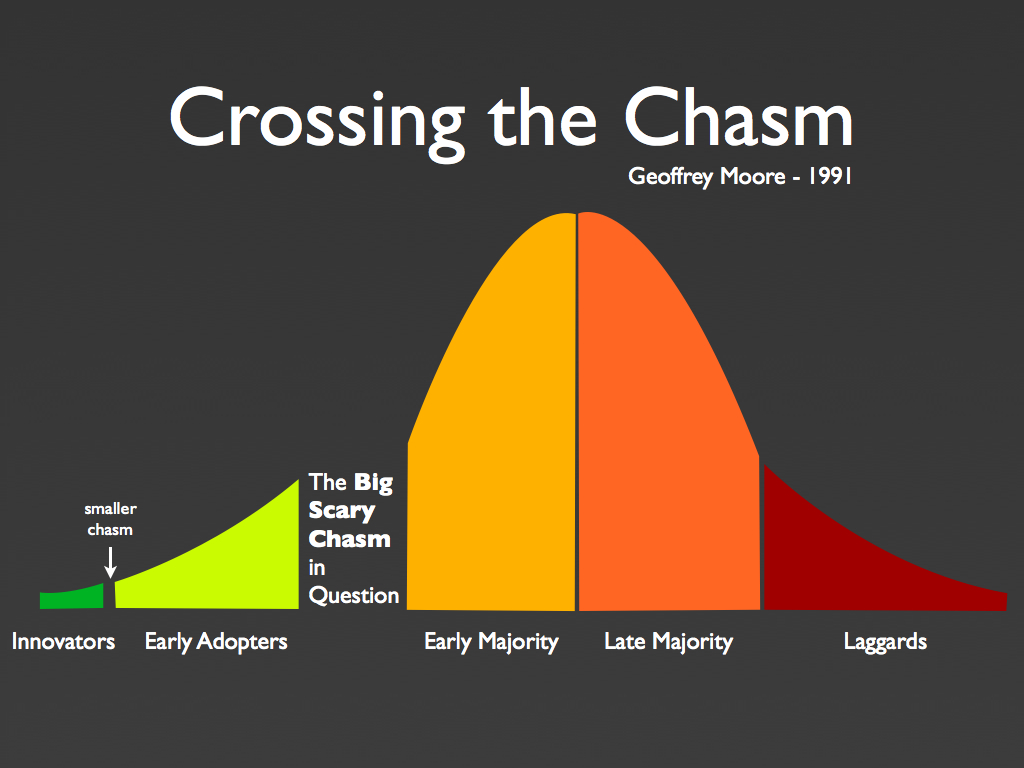Space has long been the domain of two groups: boffins and bureaucrats. The first is really smart people, the people that can calculate complex formulas in their heads while the rest of us struggle with knowing if we got the right amount of change at the store. These people become scientist and engineers. They love to solve really hard problems and gravitate toward mentally stimulating work.
The second group, the bureaucrats, have long controlled the purse-strings of the space industry, choosing who gets to do research, go into space, and so on. The bureaucrats fund the scientists and engineers, but they also build international relationships with other space agencies. The importance of their work was greater in the past and much reduced in the future.
As space goes commercial, though, it will need to "cross the chasm" (Geoffrey Moore, 1991). This means instead of creating projects for Innovators and Early Adopters, commercial space will start targeting the Early Majority.

The nature of projects before the chasm is bespoke, one-off projects for a specific purpose. Users at the beginning of the adoption curve don't mind if things are buggy. Difficult controls don't put them off. They don't worry about how beautiful something is, just that it gets the job done better than a previous solution.
What most consumers seek is substantially different. They want great user experiences coupled with beautiful design. Bugs and glitches are intolerable and things must "just work".
Products that cross the chasm look very different from those that do not. One place in the space industry to see this difference is in the design of SpaceX crew cabins and spacesuits that are spare, sleek and beautiful, compared with earlier designs that were functional but ugly.
One reason for the difference is that to cross the chasm, companies must produce systems that regular employees can manage. To get into the mass market, controls must not require a PhD to operate. This change will open the gates for normal people who will hasten making space accessible to the average Joes and Janes of the world. In the same way flying went through this normalization, there was less need for engineers, to the point today where most of the industry is pretty blue collar.
Many university-educated people hold the bigoted and entirely unfounded idea that the trades are for simple people. Reality, however, is that the trades are for people who are smart in ways that a university education cannot educate or elevate. Which is why trades people build, run and maintain most of our world and without them the world comes crashing down pretty quickly.
As public budget constraints for space mount and commercial space becomes increasingly self-funding, bureaucrats will find themselves less relevant. If space becomes more trades-oriented, however, bureaucrats can revitalize their role by helping our trade schools develop curriculum for this new class of trades. Since provinces regulate trades, space companies must work with all the provinces to get new trades developed and existing trade education upgraded. The CSA should advocate for the change, but they fight inertia and long-vested interests in keeping the status quo. Commercial companies should not trust or wait for them to take the lead.
In about 50 years of Canadian involvement in space on 17 Canadian astronauts few into space. For Canadian space to explode requires greater vision and vigour that standardization and commercialization will bring to the mass market. The next goal is not to put 2-3 more astronauts into space but 20-30,000.
Photo by Simon Berger on Unsplash
